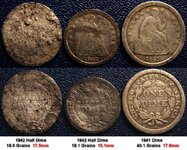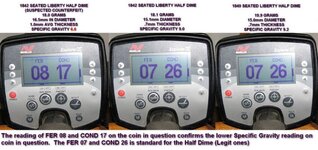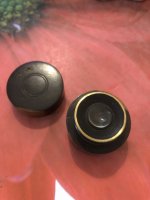Don in SJ
Silver Member
- May 20, 2005
- 4,931
- 832
- Detector(s) used
- MINELAB SE Pro
- Primary Interest:
- All Treasure Hunting
Back in September 2008 I found a silver coin that I thought was just a fire damaged Half Dime, and logged it in my records and put the coin away. Recently I started a project where I am reweighing and measuring all of my colonials and also some of the US coins that I have found over the years.
When I weighed and measured this 1842 "fire damaged" Half Dime I realized that something is amiss. The weight as seen in my attached photo is in-line with a regular 1842 half dime found by me, but the diameter is much larger. I got out a 1841 dime and weighed and measured that and the diameter of my Half Dime is much closer to the Dime than the Half Dime!
With the pock marks on the "fired damaged" Half Dime, I thought perhaps it was just a pewter mixed counterfeit, but if so, how did the spacing match the Dime (example, look at the distance from bottom of coin to the lower area of Liberty, and the spacing of the letters matches the Dime also.....
So, can anybody explain to me what went on with this coin? With the weight being correct for a 1842 Half Dime, but the Diameter being way too large, and very close to a Dime, and the spacing more like the Dime than the tiny Half Dime, how was this done?
On the metal detector the "fire damaged" dime does not read like the real 1842 Half Dime does, it thuds when dropped, so I am fairly certain it is not of the silver content the other 1842 dime is, or perhaps a fire lowers its purity somehow but yet the weight is basically the same.
For now I have to think it is a pewter counterfeit half dime, that somehow is on a dime sized planchet, but how the spacing matches a dime on the letters and other measurements, has me stumped. There is reeding on the edge of the coin in question. I also now think it is not perhaps a fire damaged coin, but just that way from perhaps being a pewter mixture, but I do remember charcoal in the ground where found.........
The photo is of all three coins laying next to each other so the size comparison is obvious and the letter and feature spacing........... Only the Obverse and Reverse groups of photos were stitched together.
Don
When I weighed and measured this 1842 "fire damaged" Half Dime I realized that something is amiss. The weight as seen in my attached photo is in-line with a regular 1842 half dime found by me, but the diameter is much larger. I got out a 1841 dime and weighed and measured that and the diameter of my Half Dime is much closer to the Dime than the Half Dime!
With the pock marks on the "fired damaged" Half Dime, I thought perhaps it was just a pewter mixed counterfeit, but if so, how did the spacing match the Dime (example, look at the distance from bottom of coin to the lower area of Liberty, and the spacing of the letters matches the Dime also.....
So, can anybody explain to me what went on with this coin? With the weight being correct for a 1842 Half Dime, but the Diameter being way too large, and very close to a Dime, and the spacing more like the Dime than the tiny Half Dime, how was this done?
On the metal detector the "fire damaged" dime does not read like the real 1842 Half Dime does, it thuds when dropped, so I am fairly certain it is not of the silver content the other 1842 dime is, or perhaps a fire lowers its purity somehow but yet the weight is basically the same.
For now I have to think it is a pewter counterfeit half dime, that somehow is on a dime sized planchet, but how the spacing matches a dime on the letters and other measurements, has me stumped. There is reeding on the edge of the coin in question. I also now think it is not perhaps a fire damaged coin, but just that way from perhaps being a pewter mixture, but I do remember charcoal in the ground where found.........
The photo is of all three coins laying next to each other so the size comparison is obvious and the letter and feature spacing........... Only the Obverse and Reverse groups of photos were stitched together.
Don






